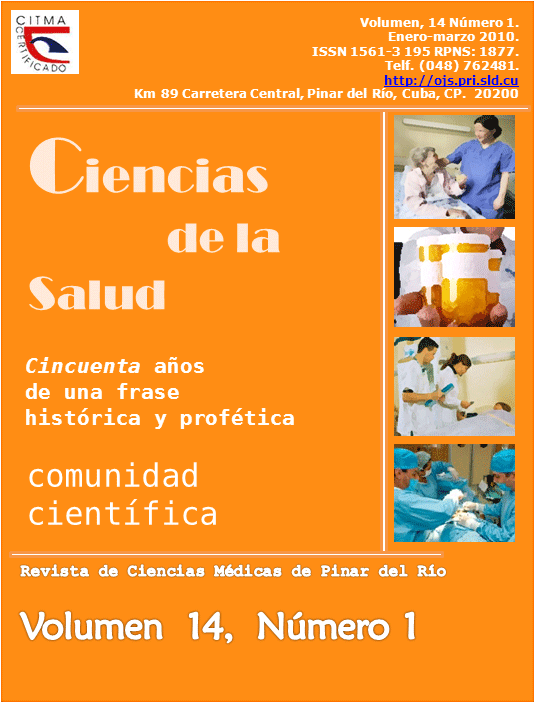A strategy for the prevention of alcoholism in twins: Pinar del Rio, 2007
Abstract
Aimed at proposing a strategy for the prevention of alcoholism in twins an epidemiological, analytical and cross-sectional research was carried out during February - March 2007 in Pinar del Rio province. The universe was taken from the National Records of twins, studying clinical, epidemiological and genealogical behavior of alcohol consumption in twins. To collect the information a survey and a genealogical tree for each family were made. Also calculating twin's concordance for the par, case rate and inheritance; data were presented in tables and graphics; prevailing alcoholic patients older than 40 years old and male sex. Familial history of alcoholism resulted statistically significant in the group of first degree relatives. The concordance was greater in monozygotic than in dizygotic twins and genetic contribution for the alcoholism reached 66%. A strategy based on the principles of genetic advice to prevent alcoholism was created.Downloads
References
1. Torres Juan Rolando, Iglesias Duquesne Magaly, Turró Mármol Cruz. Consumo de alcohol y riesgo de alcoholismo. Rev Cub Med Mil [revista en la Internet]. 2000 Ago [citado 2010 Abr 07] ; 29(2): p.103-108. Disponible en: http://scielo.sld.cu/scielo.php?script=sci_arttext&pid=S0138-65572000000200005&lng=es
2. Sáiz R, Montes R.Alcoholismo. Revisiones y actualizaciones de Psiquiatria. 2004; 106(8): p.5706 - 5710.
3. Santo-Domino J, Jiménez-Arriero. Consenso sobre diagnóstico y tratamiento del alcoholismo y otras adicciones. Sociedad Española de Psiquiatría. Euromedice; 2003.
4. Escalante G, Escalante K. Historia natural del alcoholismo. Rev Facult Medic de la Univ de Los Andes. 2005; 2: p.1-2.
5. González MR. Clínica y terapéutica de las adicciones para el médico general. 2da edición. San Luis; 2002. p.3-15.
6. García Gutiérrez Eulalia, Lima Mompó Gilda, Aldana Vilas Laura, Casanova Carrillo Pedro, Feliciano Álvarez Vladimir. Alcoholismo y sociedad, tendencias actuales. Rev Cub Med Mil [revista en la Internet]. 2004 Sep [citado 2010 Abr 07]; 33(3): Disponible en: http://scielo.sld.cu/scielo.php?script=sci_arttext&pid=S0138-65572004000300007&lng=es
7. Herrera B. Alcoholismo y sociedad. Rev méd electrón [Revista en línea] 2006[Consultado Noviembre 2007]; 28(5). Disponible en: http://www.cpimtz.sld.cu/revistamedica/año2006/
8. Rodríguez Santos Olimpio, Baldo Soria Reinaldo, Cardoso Cristiá Sandra. Consumo de alcohol: Alcoholismo y rasgos psicológicos de la personalidad. Rev Cubana Med Gen Integr [revista en la Internet]. 2000 Jun [citado 2010 Abr 07]; 16(3): p.255-259. Disponible en: http://scielo.sld.cu/scielo.php?script=sci_arttext&pid=S0864-21252000000300007&lng=es
9. Sandoval Ferrer Juan Emilio, Lanigan Gutiérrez María Eugenia, Gutiérrez Chapman Lázaro. Conocimientos y actitudes de la población acerca del alcohol y el alcoholismo. Rev Cubana Med Gen Integr [revista en la Internet]. 2000 Feb [citado 2010 Abr 07]; 16(1): p.13-17. Disponible en: http://scielo.sld.cu/scielo.php?script=sci_arttext&pid=S0864-21252000000100003&lng=es
10. Cuevas J. Patología orgánica derivada del consumo del alcohol. En: Cuevas J, Sanchís M. Tratado de alcoholaría. Madrid: Nilo[Serie en Internet] 2006[Consultado 17 de Noviembre 2007] Disponible en: http://www.scielo.cl/scielo.php/lng_es
11. Schuckit MA. Biological vulnerability to alcoholism. Journal of Consulting and Clinical Psychology .2002; 55(3): p.301-309.
12. Pickens RW, Svikis DS. The twin method in the study of vulnerability to drug abuse. In: Pickens RW, Svikis DS. Biological Vulnerability to Drug Abuse. National Institute on Drug Abuse Research Monograph Series .2004; 89: p.41-51.
13. Boomsma D, Busjahn A, Peltonen L. Classical Twin studies and beyond. Nature reviews / Genetics [Serie en Internet] 2005[Consultado 17 de Noviembre 2007] Disponible en: http://www.nature.com/reviews/genetics
14. Bolet Astoviza Miriam, Socarrás Suárez María Matilde. El alcoholismo, consecuencias y prevención. Rev Cubana Invest Bioméd [revista en la Internet]. 2003 Mar [citado 2010 Abr 07]; 22(1): Disponible en: http://scielo.sld.cu/scielo.php?script=sci_arttext&pid=S0864-03002003000100004&lng=es
15. Goldman L, Ausiello D. Cecil Textbook of Medicine. 22nd ed. Philadelphia, Pa: WB Saunders; 2004.
16. Nasiff-Hadad Alfredo, Gira Phillipe, Bruckert Erick. Efectos del alcohol sobre las lipoproteínas. Rev cubana med [periódico na Internet]. 1997 Abr [citado 2010 Abr 07]; 36(1): p.51-60. Disponible en: http://scielo.sld.cu/scielo.php?script=sci_arttext&pid=S0034-75231997000100009&lng=pt
17. Arriero MA, Hoenicka J, Aragüés M. Alcoholismo Y TaqI-A. Avances neurocientíficos y realidad clínica" Sistema dopaminérgico y trastorno. Psiquiátricos; 2005.
18. Vieyra S Gonzalo, Moraga V Mauricio, Henríquez B Hugo, Aboitiz D Francisco, Rothhammer E Francisco. Distribución de alelos de los genes DRD4 y DAT1 del sistema dopaminérgico en la población mixta de Santiago de Chile. Rev. méd. Chile [periódico na Internet]. 2003 Fev[citado 2010 Abr 07]; 131(2): p.135-143. Disponível em: http://www.scielo.cl/scielo.php?script=sci_arttext&pid=S0034-98872003000200002&lng=pt
19. Room R, Babor T, Reh J. Alcohol and public health. Lancet .2005; 365: p.519- 30.
Published
How to Cite
Issue
Section
License
Authors who have publications with this journal agree to the following terms: Authors will retain their copyrights and grant the journal the right of first publication of their work, which will be publication of their work, which will be simultaneously subject to the Creative Commons Attribution License (CC-BY-NC 4.0) that allows third parties to share the work as long as its author and first publication in this journal are indicated.
Authors may adopt other non-exclusive license agreements for distribution of the published version of the work (e.g.: deposit it in an institutional telematic archive or publish it in a volume). Likewise, and according to the recommendations of the Medical Sciences Editorial (ECIMED), authors must declare in each article their contribution according to the CRediT taxonomy (contributor roles). This taxonomy includes 14 roles, which can be used to represent the tasks typically performed by contributors in scientific academic production. It should be consulted in monograph) whenever initial publication in this journal is indicated. Authors are allowed and encouraged to disseminate their work through the Internet (e.g., in institutional telematic archives or on their web page) before and during the submission process, which may produce interesting exchanges and increase citations of the published work. (See The effect of open access). https://casrai.org/credit/



